Netgear DGND3700-100NAS User manual
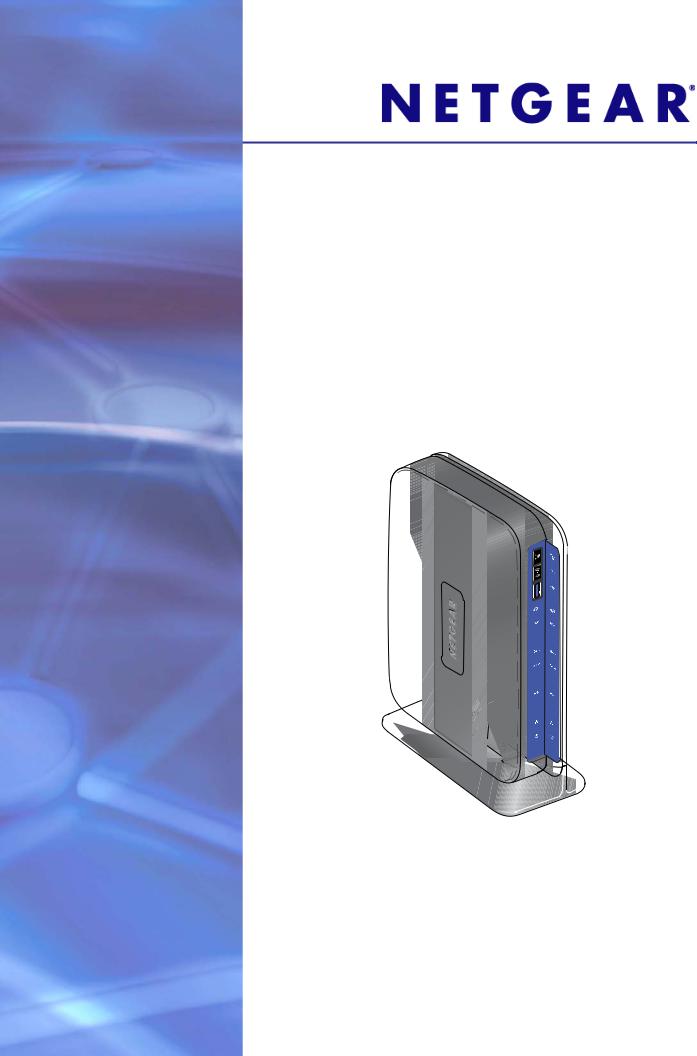
N600 Wireless Dual Band
Gigabit ADSL2+ Modem
Router DGND3700
User Manual
350 East Plumeria Drive
San Jose, CA 95134
USA
June 2011 202-10642-02 v1.0

N600 Wireless Dual Band Gigabit ADSL2+ Modem Router DGND3700
© 2011 NETGEAR, Inc. All rights reserved
No part of this publication may be reproduced, transmitted, transcribed, stored in a retrieval system, or translated into any language in any form or by any means without the written permission of NETGEAR, Inc.
Technical Support
Thank you for choosing NETGEAR. To register your product, get the latest product updates, get support online, or for more information about the topics covered in this manual, visit the Support website at http://support.netgear.com.
Phone (US & Canada only): 1-888-NETGEAR
Phone (Other Countries): Check the list of phone numbers at
http://support.netgear.com/app/answers/detail/a_id/984.
Trademarks
NETGEAR, the NETGEAR logo, and Connect with Innovation are trademarks and/or registered trademarks of NETGEAR, Inc. and/or its subsidiaries in the United States and/or other countries. Information is subject to change without notice. Other brand and product names are registered trademarks or trademarks of their respective holders. © 2011 NETGEAR, Inc. All rights reserved.
Statement of Conditions
To improve internal design, operational function, and/or reliability, NETGEAR reserves the right to make changes to the products described in this document without notice. NETGEAR does not assume any liability that may occur due to the use, or application of, the product(s) or circuit layout(s) described herein.
2

Contents
Chapter 1 Hardware Setup
Unpack Your New Router. . . . . . . . . . . . . . . . . . . . . . . . . . . . . . . . . . . . . . 11
Hardware Features. . . . . . . . . . . . . . . . . . . . . . . . . . . . . . . . . . . . . . . . . . . 12
Label. . . . . . . . . . . . . . . . . . . . . . . . . . . . . . . . . . . . . . . . . . . . . . . . . . . . 12
Back Panel . . . . . . . . . . . . . . . . . . . . . . . . . . . . . . . . . . . . . . . . . . . . . . . 13
Front Panel . . . . . . . . . . . . . . . . . . . . . . . . . . . . . . . . . . . . . . . . . . . . . . . 14
Position Your Wireless Router . . . . . . . . . . . . . . . . . . . . . . . . . . . . . . . . . . 17
ADSL Microfilters . . . . . . . . . . . . . . . . . . . . . . . . . . . . . . . . . . . . . . . . . . . . 18
One-Line ADSL Microfilter (Not Included) . . . . . . . . . . . . . . . . . . . . . . . 18
Two-Line ADSL Microfilter (Included). . . . . . . . . . . . . . . . . . . . . . . . . . . 19
Summary . . . . . . . . . . . . . . . . . . . . . . . . . . . . . . . . . . . . . . . . . . . . . . . . 19
Cable Your N600 Wireless Modem Router . . . . . . . . . . . . . . . . . . . . . . . . 20
Verify the Cabling . . . . . . . . . . . . . . . . . . . . . . . . . . . . . . . . . . . . . . . . . . . . 20
For More Information . . . . . . . . . . . . . . . . . . . . . . . . . . . . . . . . . . . . . . . . . 21
Chapter 2 Router Internet Setup
Router Setup Preparation. . . . . . . . . . . . . . . . . . . . . . . . . . . . . . . . . . . . . . 23 Use Standard TCP/IP Properties for DHCP . . . . . . . . . . . . . . . . . . . . . . 23 Replace an Existing Router . . . . . . . . . . . . . . . . . . . . . . . . . . . . . . . . . . 23 Adapters and Security Settings . . . . . . . . . . . . . . . . . . . . . . . . . . . . . . . 23 Gather ISP Information. . . . . . . . . . . . . . . . . . . . . . . . . . . . . . . . . . . . . . 23
Log In to the N600 Modem Router . . . . . . . . . . . . . . . . . . . . . . . . . . . . . . . 24 Upgrade Router Firmware . . . . . . . . . . . . . . . . . . . . . . . . . . . . . . . . . . . . . 25 Router Interface . . . . . . . . . . . . . . . . . . . . . . . . . . . . . . . . . . . . . . . . . . . . . 26 Setup Wizard . . . . . . . . . . . . . . . . . . . . . . . . . . . . . . . . . . . . . . . . . . . . . . . 27 Manual Setup (Basic Settings) . . . . . . . . . . . . . . . . . . . . . . . . . . . . . . . . . . 28 ADSL Settings . . . . . . . . . . . . . . . . . . . . . . . . . . . . . . . . . . . . . . . . . . . . . . 32 Unsuccessful Internet Connection . . . . . . . . . . . . . . . . . . . . . . . . . . . . . . . 33 Change Password and Login Time-Out . . . . . . . . . . . . . . . . . . . . . . . . . . . 33 Log Out Manually . . . . . . . . . . . . . . . . . . . . . . . . . . . . . . . . . . . . . . . . . . . . 34 Types of Logins . . . . . . . . . . . . . . . . . . . . . . . . . . . . . . . . . . . . . . . . . . . . . 34
Chapter 3 Wireless Settings
Wireless Security Requirements and Recommendations . . . . . . . . . . . . .37 Wireless Security Basics . . . . . . . . . . . . . . . . . . . . . . . . . . . . . . . . . . . . . . 37 Turn Off Wireless Connectivity . . . . . . . . . . . . . . . . . . . . . . . . . . . . . . . . 38 Disable SSID Broadcast . . . . . . . . . . . . . . . . . . . . . . . . . . . . . . . . . . . . . 38 Restrict Access by MAC Address. . . . . . . . . . . . . . . . . . . . . . . . . . . . . . 38 Wireless Security Options . . . . . . . . . . . . . . . . . . . . . . . . . . . . . . . . . . . 38
3

N600 Wireless Dual Band Gigabit ADSL2+ Modem Router DGND3700
Add Clients (Devices) to Your Network . . . . . . . . . . . . . . . . . . . . . . . . . . . 40 Manual Method. . . . . . . . . . . . . . . . . . . . . . . . . . . . . . . . . . . . . . . . . . . . 40 Wi-Fi Protected Setup (WPS) Method . . . . . . . . . . . . . . . . . . . . . . . . . . 40 Wireless Settings Screen . . . . . . . . . . . . . . . . . . . . . . . . . . . . . . . . . . . . . . 42 Consider Every Device on Your Network . . . . . . . . . . . . . . . . . . . . . . . . 42 Configure Wireless Settings . . . . . . . . . . . . . . . . . . . . . . . . . . . . . . . . . . 43
Chapter 4 Security Settings
Keyword Blocking of HTTP Traffic . . . . . . . . . . . . . . . . . . . . . . . . . . . . . . . 49 Delete a Keyword or Domain . . . . . . . . . . . . . . . . . . . . . . . . . . . . . . . . . 49 Specify a Trusted Computer. . . . . . . . . . . . . . . . . . . . . . . . . . . . . . . . . . 49 Firewall Rules to Control Network Access . . . . . . . . . . . . . . . . . . . . . . . . . 50 Remote Computer Access Basics . . . . . . . . . . . . . . . . . . . . . . . . . . . . . 50 Port Triggering to Open Incoming Ports . . . . . . . . . . . . . . . . . . . . . . . . . 51 Port Forwarding to Permit External Host Communications . . . . . . . . . . 53 How Port Forwarding Differs from Port Triggering . . . . . . . . . . . . . . . . . 53 Configure Port Forwarding to Local Servers . . . . . . . . . . . . . . . . . . . . . 54 Configure Port Triggering . . . . . . . . . . . . . . . . . . . . . . . . . . . . . . . . . . . . 56 Configure Services . . . . . . . . . . . . . . . . . . . . . . . . . . . . . . . . . . . . . . . . . . . 58 Set the Time Zone . . . . . . . . . . . . . . . . . . . . . . . . . . . . . . . . . . . . . . . . . . . 59 Schedule Firewall Services . . . . . . . . . . . . . . . . . . . . . . . . . . . . . . . . . . . . 60 Enable Security Event Email Notification . . . . . . . . . . . . . . . . . . . . . . . . . . 60 Log the Network Activity. . . . . . . . . . . . . . . . . . . . . . . . . . . . . . . . . . . . . . . 62
Chapter 5 Network Maintenance
Upgrade the Router Firmware . . . . . . . . . . . . . . . . . . . . . . . . . . . . . . . . . . 65 Automatic Firmware Checking Off . . . . . . . . . . . . . . . . . . . . . . . . . . . . . 65 Automatic Firmware Checking On . . . . . . . . . . . . . . . . . . . . . . . . . . . . . 66 Manually Check for Firmware Upgrades . . . . . . . . . . . . . . . . . . . . . . . . . . 66 Manage Configuration File . . . . . . . . . . . . . . . . . . . . . . . . . . . . . . . . . . . . . 67 Back Up . . . . . . . . . . . . . . . . . . . . . . . . . . . . . . . . . . . . . . . . . . . . . . . . . 67 Restore . . . . . . . . . . . . . . . . . . . . . . . . . . . . . . . . . . . . . . . . . . . . . . . . . . 68 Erase . . . . . . . . . . . . . . . . . . . . . . . . . . . . . . . . . . . . . . . . . . . . . . . . . . . 68 View Router Status. . . . . . . . . . . . . . . . . . . . . . . . . . . . . . . . . . . . . . . . . . . 69 Show Statistics Button . . . . . . . . . . . . . . . . . . . . . . . . . . . . . . . . . . . . . . 71 Connection Status Button. . . . . . . . . . . . . . . . . . . . . . . . . . . . . . . . . . . . 72 View Attached Devices. . . . . . . . . . . . . . . . . . . . . . . . . . . . . . . . . . . . . . . . 72 Run Diagnostic Utilities . . . . . . . . . . . . . . . . . . . . . . . . . . . . . . . . . . . . . . . 73
Chapter 6 USB Storage
USB Drive Requirements . . . . . . . . . . . . . . . . . . . . . . . . . . . . . . . . . . . . . . 75
File-Sharing Scenarios . . . . . . . . . . . . . . . . . . . . . . . . . . . . . . . . . . . . . . . . 75
Share Photos with Friends and Family. . . . . . . . . . . . . . . . . . . . . . . . . . 76
Store Files in a Central Location for Printing . . . . . . . . . . . . . . . . . . . . . 76
Share Large Files with Colleagues. . . . . . . . . . . . . . . . . . . . . . . . . . . . . 76
USB Storage Basic Settings. . . . . . . . . . . . . . . . . . . . . . . . . . . . . . . . . . . . 77
4

N600 Wireless Dual Band Gigabit ADSL2+ Modem Router DGND3700
Edit a Network Folder . . . . . . . . . . . . . . . . . . . . . . . . . . . . . . . . . . . . . . . . .79 Configure USB Storage Advanced Settings . . . . . . . . . . . . . . . . . . . . . . . .80 Create a Network Folder. . . . . . . . . . . . . . . . . . . . . . . . . . . . . . . . . . . . .81 Unmount a USB Drive . . . . . . . . . . . . . . . . . . . . . . . . . . . . . . . . . . . . . . . .82 Specify Approved USB Devices . . . . . . . . . . . . . . . . . . . . . . . . . . . . . . . . .82 Connect to the USB Drive from a Remote Computer. . . . . . . . . . . . . . . . .83 Locate the Internet Port IP Address . . . . . . . . . . . . . . . . . . . . . . . . . . . .83 Access the Router’s USB Drive Remotely Using FTP . . . . . . . . . . . . . .83 Connect to the USB Drive with Microsoft Network Settings . . . . . . . . . . . .83 Enable File and Printer Sharing . . . . . . . . . . . . . . . . . . . . . . . . . . . . . . .84 Set Up a Media Server . . . . . . . . . . . . . . . . . . . . . . . . . . . . . . . . . . . . . . . .84
Chapter 7 Virtual Private Networking
Overview of VPN Configuration . . . . . . . . . . . . . . . . . . . . . . . . . . . . . . . . .87 Client-to-Gateway VPN Tunnels. . . . . . . . . . . . . . . . . . . . . . . . . . . . . . .87 Gateway-to-Gateway VPN Tunnels . . . . . . . . . . . . . . . . . . . . . . . . . . . .87 Plan a VPN . . . . . . . . . . . . . . . . . . . . . . . . . . . . . . . . . . . . . . . . . . . . . . . . .88 VPN Tunnel Configuration . . . . . . . . . . . . . . . . . . . . . . . . . . . . . . . . . . . . .89 Set Up a Client-to-Gateway VPN Configuration . . . . . . . . . . . . . . . . . . . . .90 Step 1: Configure the Client-to-Gateway VPN Tunnel . . . . . . . . . . . . . .90 Step 2: Configure the NETGEAR ProSafe VPN Client. . . . . . . . . . . . . .93 Set Up a Gateway-to-Gateway VPN Configuration . . . . . . . . . . . . . . . . .101 VPN Tunnel Control . . . . . . . . . . . . . . . . . . . . . . . . . . . . . . . . . . . . . . . . .105 Activate a VPN Tunnel . . . . . . . . . . . . . . . . . . . . . . . . . . . . . . . . . . . . .105 Verify the Status of a VPN Tunnel . . . . . . . . . . . . . . . . . . . . . . . . . . . .108 Deactivate a VPN Tunnel . . . . . . . . . . . . . . . . . . . . . . . . . . . . . . . . . . .109 Delete a VPN Tunnel . . . . . . . . . . . . . . . . . . . . . . . . . . . . . . . . . . . . . .111 Set Up VPN Tunnels in Special Circumstances . . . . . . . . . . . . . . . . . . . .111 Use Auto Policy to Configure VPN Tunnels . . . . . . . . . . . . . . . . . . . . .112 Use Manual Policy to Configure VPN Tunnels . . . . . . . . . . . . . . . . . . .119
Chapter 8 Advanced Settings
WAN Setup. . . . . . . . . . . . . . . . . . . . . . . . . . . . . . . . . . . . . . . . . . . . . . . .123 WAN Preference. . . . . . . . . . . . . . . . . . . . . . . . . . . . . . . . . . . . . . . . . .123 Disable Port Scan and DOS Protection . . . . . . . . . . . . . . . . . . . . . . . .123 Default DMZ Server . . . . . . . . . . . . . . . . . . . . . . . . . . . . . . . . . . . . . . .123 Respond to Ping on Internet Port . . . . . . . . . . . . . . . . . . . . . . . . . . . . .124 MTU Size (in bytes) . . . . . . . . . . . . . . . . . . . . . . . . . . . . . . . . . . . . . . .124 NAT Filtering. . . . . . . . . . . . . . . . . . . . . . . . . . . . . . . . . . . . . . . . . . . . .124 Disable SIP ALG. . . . . . . . . . . . . . . . . . . . . . . . . . . . . . . . . . . . . . . . . .125
Dynamic DNS . . . . . . . . . . . . . . . . . . . . . . . . . . . . . . . . . . . . . . . . . . . . . .125 LAN Setup . . . . . . . . . . . . . . . . . . . . . . . . . . . . . . . . . . . . . . . . . . . . . . . .126 Set Up Quality of Service (QoS). . . . . . . . . . . . . . . . . . . . . . . . . . . . . . . .128 Configure QoS for Internet Access . . . . . . . . . . . . . . . . . . . . . . . . . . . .129 Advanced Wireless Settings. . . . . . . . . . . . . . . . . . . . . . . . . . . . . . . . . . .130 Wireless Advanced Settings . . . . . . . . . . . . . . . . . . . . . . . . . . . . . . . . .131 WPS Settings . . . . . . . . . . . . . . . . . . . . . . . . . . . . . . . . . . . . . . . . . . . .131
5

N600 Wireless Dual Band Gigabit ADSL2+ Modem Router DGND3700
Building Wireless Bridging and Repeating Networks . . . . . . . . . . . . . . . . 132 Point-to-Point Bridge Configuration . . . . . . . . . . . . . . . . . . . . . . . . . . . 133 Multi-Point Bridge . . . . . . . . . . . . . . . . . . . . . . . . . . . . . . . . . . . . . . . . . 134 Repeater with Wireless Client Association . . . . . . . . . . . . . . . . . . . . . . 136 Remote Management. . . . . . . . . . . . . . . . . . . . . . . . . . . . . . . . . . . . . . . . 137 Static Routes . . . . . . . . . . . . . . . . . . . . . . . . . . . . . . . . . . . . . . . . . . . . . . 139 Static Route Example . . . . . . . . . . . . . . . . . . . . . . . . . . . . . . . . . . . . . . 139 Configure Static Routes . . . . . . . . . . . . . . . . . . . . . . . . . . . . . . . . . . . . 140 Universal Plug and Play . . . . . . . . . . . . . . . . . . . . . . . . . . . . . . . . . . . . . . 141 Advanced USB Settings . . . . . . . . . . . . . . . . . . . . . . . . . . . . . . . . . . . . . . 142 Traffic Meter . . . . . . . . . . . . . . . . . . . . . . . . . . . . . . . . . . . . . . . . . . . . . . . 143
Chapter 9 Troubleshooting
Router Not On . . . . . . . . . . . . . . . . . . . . . . . . . . . . . . . . . . . . . . . . . . . . . 146 Power LED Is Off . . . . . . . . . . . . . . . . . . . . . . . . . . . . . . . . . . . . . . . . . 146 Power LED Is Red . . . . . . . . . . . . . . . . . . . . . . . . . . . . . . . . . . . . . . . . 147 LAN LED Is Off . . . . . . . . . . . . . . . . . . . . . . . . . . . . . . . . . . . . . . . . . . . 147 Wireless LEDs Are Off . . . . . . . . . . . . . . . . . . . . . . . . . . . . . . . . . . . . . 147 DSL or Internet LED Is Off . . . . . . . . . . . . . . . . . . . . . . . . . . . . . . . . . . 147
No ISP Connection. . . . . . . . . . . . . . . . . . . . . . . . . . . . . . . . . . . . . . . . . . 148 ADSL Link. . . . . . . . . . . . . . . . . . . . . . . . . . . . . . . . . . . . . . . . . . . . . . . 148 Internet LED Is Red . . . . . . . . . . . . . . . . . . . . . . . . . . . . . . . . . . . . . . . 149 Cannot Obtain an Internet IP Address . . . . . . . . . . . . . . . . . . . . . . . . . 149 Debug PPPoE or PPPoA . . . . . . . . . . . . . . . . . . . . . . . . . . . . . . . . . . . 150 Cannot Load an Internet Web Page . . . . . . . . . . . . . . . . . . . . . . . . . . . 150
TCP/IP Network Not Responding. . . . . . . . . . . . . . . . . . . . . . . . . . . . . . . 150 Test the LAN Path to Your Wireless Modem Router . . . . . . . . . . . . . . 151 Test the Path from Your Computer to a Remote Device . . . . . . . . . . . 152 Cannot Log In. . . . . . . . . . . . . . . . . . . . . . . . . . . . . . . . . . . . . . . . . . . . . . 152 Changes Not Saved . . . . . . . . . . . . . . . . . . . . . . . . . . . . . . . . . . . . . . . . . 153 Firmware Needs to Be Reloaded . . . . . . . . . . . . . . . . . . . . . . . . . . . . . . . 153 Incorrect Date or Time . . . . . . . . . . . . . . . . . . . . . . . . . . . . . . . . . . . . . . . 154
Appendix A Supplemental Information
Factory Settings . . . . . . . . . . . . . . . . . . . . . . . . . . . . . . . . . . . . . . . . . . . . 156
Technical Specifications. . . . . . . . . . . . . . . . . . . . . . . . . . . . . . . . . . . . . . 158
Appendix B NETGEAR VPN Configuration
Configuration Profile. . . . . . . . . . . . . . . . . . . . . . . . . . . . . . . . . . . . . . . . . 159 Step-by-Step Configuration . . . . . . . . . . . . . . . . . . . . . . . . . . . . . . . . . 160 Wireless Modem Router with FQDN to Gateway B . . . . . . . . . . . . . . . . . 162 Configuration Profile . . . . . . . . . . . . . . . . . . . . . . . . . . . . . . . . . . . . . . . 162 Step-by-Step Configuration . . . . . . . . . . . . . . . . . . . . . . . . . . . . . . . . . 163 Configuration Summary (Telecommuter Example) . . . . . . . . . . . . . . . . . 166 Set Up Client-to-Gateway VPN (Telecommuter Example). . . . . . . . . . . . 167 Step 1: Configure Gateway A (VPN Router at Main Office) . . . . . . . . . 168
6

N600 Wireless Dual Band Gigabit ADSL2+ Modem Router DGND3700
Step 2: Configure Gateway B (VPN Router at Regional Office) . . . . . .169 Monitoring the VPN Tunnel (Telecommuter Example) . . . . . . . . . . . . . . .175 View the VPN Router’s VPN Status and Log Information. . . . . . . . . . .176
Appendix C Notification of Compliance
Index
7

1. Hardware Setup |
1 |
Getting to know your wireless router |
The NETGEAR N600 Wireless Dual Band Gigabit ADSL2+ Modem Router DGND3700 is the Ultimate Integrated ADSL Networking Gateway. It offers concurrent dual-band technology that allows devices to avoid interference and also ensures top speeds and the greatest range for demanding applications, such as streaming HD video and multiplayer gaming. Complete with a built-in ADSL modem, it is compatible with all major ADSL Internet service providers. The Gigabit port on the WAN side also has an option to connect to a fiber/cable modem.
•All-in-one. Built-in ADSL2+ modem and WAN Gigabit Ethernet port for cable/fiber combined with a wireless router create the ultimate integrated home gateway.
•Concurrent dual band. Ensures top speeds and the greatest range while minimizing interference.
•Faster multimedia streaming. Provides Wireless-N speed for streaming HD videos, simultaneous downloads, and online gaming in addition to basic Internet applications.
•Shared storage. Two (2) ports for ReadySHARE® USB storage access provide fast and easy shared access to an external USB storage device.
•Live Parental Controls. Keep your Internet experience safe.
•Guest network access. Provides separate security and access restrictions for guests using the network.
•Secured connection. Push 'N' Connect ensures a quick and secure network connection.
•Broadband usage meter. Monitors Internet traffic and sends customized reports to help keep costs under control.
•Easy installation. Connect to PC and open your browser to install.
•Compatibility. Compatible with all major ADSL Internet service providers (ISPs).
•Broadband usage meter. Monitors Internet traffic and sends customized reports to help keep costs under control.
Product specifications
Package Contents
•N600 Wireless Dual Band Gigabit ADSL2+ Modem Router DGND3700
•Ethernet cable
•Phone cable and filter
•Power adapter, localized to country of sale
8

N600 Wireless Dual Band Gigabit ADSL2+ Modem Router DGND3700
Warranty
•NETGEAR 1-year warranty System Requirements
•Broadband Internet service
-ADSL broadband Internet service
-Cable or fiber: Connects to cable modem or fiber termination node through the Gigabit Ethernet WAN port
•802.11 a/b/g/n 2.4 or 5.0 GHz specification wireless adapter or an Ethernet adapter and cable for each computer
•Microsoft Windows 7, Vista, XP, 2000, Me, Mac OS, UNIX, or Linux
•Microsoft Internet Explorer 5.0, Firefox 2.0, Safari 1.4, or later
•Use with an N600 Wireless Dual Band USB Adapter (WNDA3100 for maximum performance)
Standards
•IEEE 802.11 b/g/n 2.4 GHz
•IEEE 802.11 a/n 5.0 GHz
•Five (5) 10/100/1000 (1 WAN and 4 LAN) Gigabit Ethernet ports
•Two (2) USB 2.0 ports
•One (1) ADSL2+ port Performance
•All-in-one. High-speed ADSL2+ modem (built-in) and WAN Gigabit Ethernet port for cable/fiber
•Powerful dual-core (400 MHz each) processor
•High-speed access to external USB storage using two USB 2.0 ports
•Memory: 128 MB flash and 128 MB RAM
•Five (5) (1 WAN, 4 LAN) Gigabit Ethernet ports
•Advanced Quality of Service (QoS)
Security
•Wi-Fi Protected Access® (WPA/WPA2—PSK) and WEP
•Double firewall protection (SPI and NAT firewall)
•Denial-of-service (DoS) attack prevention
Ease of Use
•Easy installation. Connect to PC and open your browser to install
•Push 'N' Connect using Wi-Fi Protected Setup® (WPS)
Physical Specifications
•Dimensions: 223 x 153 x 31 mm (8.8 x 6.0 x 1.2 in)
Hardware Setup
9
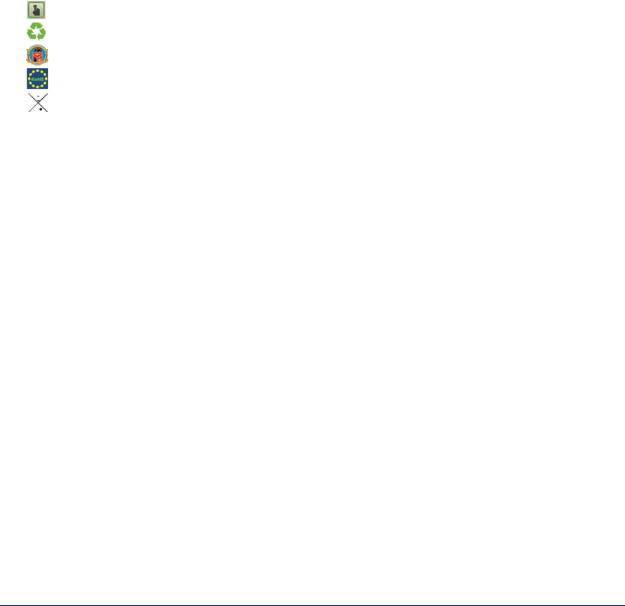
N600 Wireless Dual Band Gigabit ADSL2+ Modem Router DGND3700
•Weight: 0.5 kg (1.2 lb) Advanced Features
•Live Parental Controls with flexible and customizable filter settings.
•Simultaneous dual band. 2.4 GHz and 5 GHz operation.
•Two (2) ports for ReadySHARE® USB storage access. Supports FAT16/32, NTFS Read/Write.
•DLNA®. Stream media to DLNA media players.
•Multiple SSID guest networks (separate security and access restrictions).
•Broadband usage meter measures Internet usage.
•Power and Wi-Fi On/Off buttons.
NETGEAR Green Features
Power On/Off button
80% recycled packaging
CEC (California Efficiency)
RoHS
WEEE
If you have not already set up your new router using the installation guide that comes in the box, this chapter walks you through the hardware setup. Chapter 2, Router Internet Setup, explains how to set up your Internet connection.
This chapter contains the following sections:
•Unpack Your New Router
•Hardware Features
•Position Your Wireless Router
•ADSL Microfilters
•Cable Your N600 Wireless Modem Router
•Verify the Cabling
•For More Information
Hardware Setup
10

N600 Wireless Dual Band Gigabit ADSL2+ Modem Router DGND3700
Unpack Your New Router
Your box should contain the following items:
•N600 Wireless Dual Band Gigabit ADSL2+ Modem Router DGND3700
•AC power adapter (plug varies by region)
•Category 5 (Cat 5) Ethernet cable
•Telephone cable with RJ-11 connector
•Microfilters and splitters (quantity and type vary by region)
•Installation guide with cabling and router setup instructions
If any of the parts are incorrect, missing, or damaged, contact your NETGEAR dealer. Keep the carton, including the original packing materials, in case you need to return the product for repair. See Position Your Wireless Router on page 17 for information about where to place and how to position your router.

 ADSL
ADSL
Phone







 Line
Line
ADSL filter
N600 Wireless Modem Router |
Ethernet cable |
|
|
|
|
|
|||||||||||||||
|
|
|
|
|
|
|
|
|
|
|
|
|
|
|
|
|
|
|
|
|
|
|
|
|
|
|
|
|
|
|
|
|
|
|
|
|
|
|
|
|
|
|
|
|
|
|
|
|
|
|
|
|
|
|
|
|
|
|
|
|
|
|
|
|
|
Phone cable |
Power adapter |
Figure 1. Box contents
Hardware Setup
11
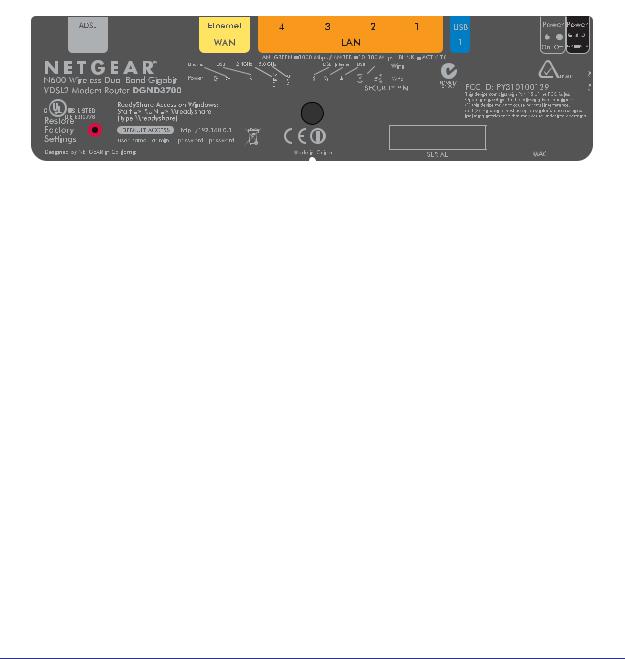
N600 Wireless Dual Band Gigabit ADSL2+ Modem Router DGND3700
Hardware Features
Before you cable your router, take a moment to become familiar with the label and the front and back panels. Pay particular attention to the LEDs on the front panel.
Label
The label on the bottom of the wireless modem router shows the router’s Restore Factory Settings button, WPS security PIN, MAC address, and serial number.
|
|
|
|
|
|
|
|
|
WPS Security PIN |
|
MAC address |
|||||||||||||
|
|
|
|
|
|
|
|
|
|
|
|
|
|
|
|
|
|
|
|
|
|
|
|
|
|
|
|
|
|
|
|
|
|
|
|
|
|
|
|
|
|
|
|
|
|
|
|
|
|
|
|
|
|
|
|
|
|
|
|
|
|
|
|
|
|
|
|
|
|
|
|
|
|
|
|
|
|
|
|
|
|
|
|
|
|
|
|
|
|
|
|
|
|
|
|
|
|
|
|
|
|
|
|
|
|
|
|
|
|
|
|
|
|
|
|
|
|
|
|
|
|
|
|
|
|
|
|
|
|
|
|
|
|
|
|
|
|
|
|
|
|
|
|
|
|
|
|
|
|
|
|
|
|
|
|
|
|
|
|
|
|
|
|
|
|
|
|
|
|
|
|
|
|
|
|
|
|
|
|
|
|
|
|
|
|
|
|
|
|
|
|
|
|
|
|
|
|
|
|
|
|
|
|
|
|
|
|
|
|
|
|
|
|
|
|
|
|
|
|
|
|
|
|
|
|
|
|
|
|
|
|
|
|
|
|
|
|
|
|
|
|
|
|
|
|
|
|
|
|
|
|
|
|
|
|
|
|
|
|
|
|
|
|
|
|
|
|
|
|
|
|
|
|
|
|
|
|
|
|
|
|
|
|
|
|
|
|
|
|
|
|
|
|
|
|
|
|
|
|
|
|
|
|
|
|
|
|
|
|
|
|
|
|
|
|
|
|
|
|
|
|
|
|
|
|
|
|
|
|
|
|
|
|
|
|
|
|
|
|
|
|
|
|
|
|
|
|
|
|
Restore Factory Settings |
Serial number |
Figure 2. Label on router bottom
See Factory Settings on page 156 for information about the Restore Factory Settings button and the factory setting values.
Hardware Setup
12
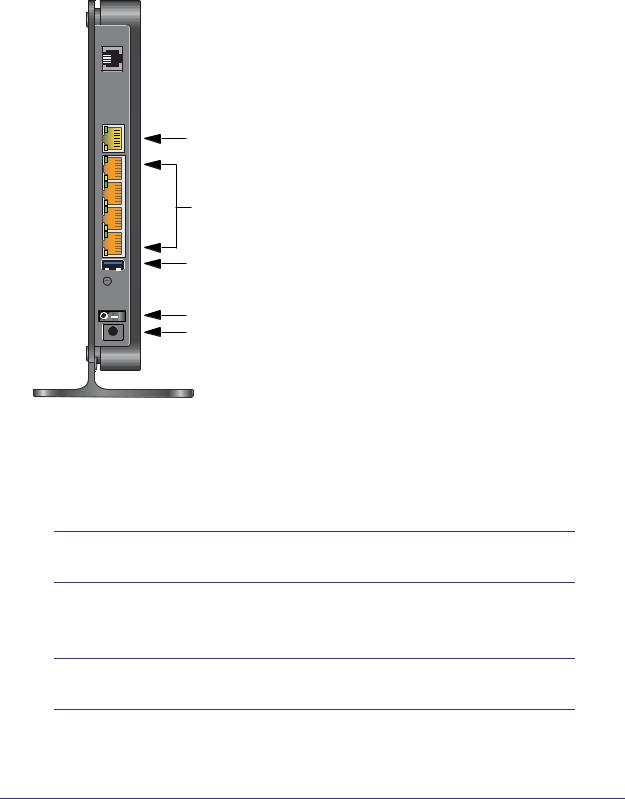
N600 Wireless Dual Band Gigabit ADSL2+ Modem Router DGND3700
Back Panel
The back panel has the Power On/Off button and port connections shown in the figure:
 1. ADSL line
1. ADSL line
2. Gigabit port for connecting to external cable/fiber modem
3. Gigabit Ethernet ports
4. USB port
5. Power On/Off button
6. AC power adapter input
Figure 3. Back panel port connections
Viewed from left to right, the rear panel contains the following elements:
1.RJ-11 asynchronous DSL (ADSL) port for connecting the wireless modem router to an ADSL line
Note: An ADSL port is capable of sending data over an ADSL line at one speed and receiving it at another speed.
2. Ethernet WAN port for connecting the wireless modem router to a fiber/cable modem
Note: You can use either the ADSL or Gigabit Ethernet port for WAN connectivity.
3. Four Ethernet RJ-45 LAN ports for cabling the wireless modem router to the local computers
Hardware Setup
13
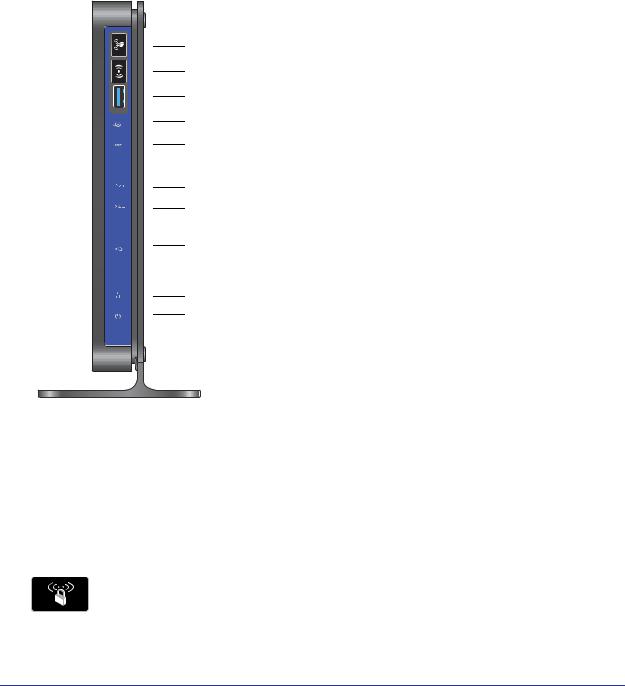
N600 Wireless Dual Band Gigabit ADSL2+ Modem Router DGND3700
4.USB port for connecting USB storage devices like flash drives or hard drives
5.Power On/Off button
6.AC power adapter input
Front Panel
The wireless modem router front panel has the 10 status LEDs, icons, and ports shown in the figure. Note that the Wireless and WPS icons are buttons.
WPS On/Off button
Wireless On/Off button
USB port
Internet
DSL
5 GHZ wireless
2.4 GHz wireless
USB
LAN ports
Power
Figure 4. Front panel LEDs
The following tables describe the LEDs, icons, and buttons on the front panel from top to bottom.
Table 1. WPS button and LED
Icon |
LED Activity |
Description |
|
|
|
|
Solid green |
Indicates that wireless security has been enabled. |
|
|
|
|
Blinking green |
WPS-capable device is connecting to the device. |
|
|
|
|
Off |
WPS is not enabled. For information about the use of this button, see Wi-Fi |
|
|
Protected Setup (WPS) Method on page 40. |
|
|
|
Hardware Setup
14

N600 Wireless Dual Band Gigabit ADSL2+ Modem Router DGND3700
Table 2. Wireless button
Icon Description
For information about the use of this button, see Turn Off Wireless Connectivity on page 38.
Table 3. USB port
Icon Description
USB port for connecting USB storage devices like flash drives or hard drives.
Table 4. Internet LED
Icon |
|
|
LED Activity |
Description |
|
|
|
|
|
|
|
|
|
|
|
Solid green |
You have an Internet connection. If this connection is dropped due to an |
|
|
|
|||
|
|
|
|
|
idle time-out but the connection is still present, the light stays green. If the |
|
|
|
|
|
Internet connection is dropped for any other reason, the light turns off. |
|
|
|
|
|
|
|
|
|
|
Solid red |
The Internet (IP) connection failed. See No ISP Connection on page 148 |
|
|
|
|
|
for troubleshooting information. |
|
|
|
|
|
|
|
|
|
|
Blinking green |
Data is being transmitted over the Internet connection. |
|
|
|
|
|
|
|
|
|
|
Off |
No Internet connection is detected or the device is in bridge mode (an |
|
|
|
|
|
external device handles the ISP connection). |
|
|
|
|
|
|
Table 5. DSL LED
Icon |
|
|
LED Activity |
Description |
|
|
|
|
|
|
|
|
|
|
|
Solid green |
You have an ADSL connection. In technical terms, the ADSL port is |
|
|
|
|||
|
|
|
|
|
synchronized with an ISP’s network-access device. |
|
|
|
|
|
|
|
|
|
|
Blinking green |
Indicates that the wireless modem router is negotiating the best possible |
|
|
|
|
||
|
|
|
|
|
speed on the ADSL line. |
|
|
|
|
|
|
|
|
|
|
Off |
The unit is off or there is no IP connection. |
|
|
|
|
|
|
Hardware Setup
15

N600 Wireless Dual Band Gigabit ADSL2+ Modem Router DGND3700
Table 6. 5 GHz Wireless LED
Icon |
|
|
LED Activity |
Description |
|
|
|
|
|
|
|
|
|
|
|
Solid blue |
There is wireless connectivity. |
|
|
|
|||
|
|
|
|
|
|
|
|
|
|
Blinking blue |
Data is being transmitted or received over the 5 GHz wireless link. |
|
|
|
|
|
|
|
|
|
|
Off |
There is no wireless connectivity. You can still plug an Ethernet cable into |
|
|
|
|
|
one of the LAN ports to get wired connectivity. |
|
|
|
|
|
|
Table 7. 2.4 GHz Wireless LED
Icon |
|
|
LED Activity |
Description |
|
|
|
|
|
|
|
|
|
|
|
Solid green |
There is wireless connectivity. |
|
|
|
|||
|
|
|
|
|
|
|
|
|
|
Blinking green |
Data is being transmitted or received over the 2.4 GHz wireless link. |
|
|
|
|
|
|
|
|
|
|
Off |
There is no wireless connectivity. You can still plug an Ethernet cable into |
|
|
|
|
|
one of the LAN ports to get wired connectivity. |
|
|
|
|
|
|
Table 8. USB LED
Icon |
|
|
LED Activity |
Description |
|
|
|
|
|
|
|
|
|
|
|
Solid green |
A USB port has detected a USB device. |
|
|
|
|||
|
|
|
|
|
|
|
|
|
|
Blinking green |
Data is being transmitted or received. |
|
|
|
|
|
|
|
|
|
|
Off |
No link is detected on these ports. |
|
|
|
|
|
|
Table 9. LAN LED
Icon |
|
|
LED Activity |
Description |
|
|
|
|
|
|
|
|
|
|
|
Solid green |
A LAN port has detected an Ethernet link with a device. |
|
|
|
|||
|
|
|
|
|
|
|
|
|
|
Blinking green |
Data is being transmitted or received. |
|
|
|
|
|
|
|
|
|
|
Off |
No link is detected on these ports. |
|
|
|
|
|
|
Hardware Setup
16

N600 Wireless Dual Band Gigabit ADSL2+ Modem Router DGND3700
Table 10. Power On/Off LED
Icon |
|
|
LED Activity |
Description |
|
|
|
|
|
|
|
|
|
|
|
Solid green |
Power is supplied to the router. |
|
|
|
|||
|
|
|
|
|
|
|
|
|
|
Solid red |
POST (power-on self-test) failure or a device malfunction has occurred. |
|
|
|
|
|
|
|
|
|
|
Off |
Power is not supplied to the router. |
|
|
|
|
|
|
|
|
|
|
Restore Factory |
Light blinks momentarily when the Restore Factory Settings button on the |
|
|
|
|
Settings |
bottom of the unit is pressed for 6 seconds. The Power LED then blinks red |
|
|
|
|
|
three times when the Restore Factory Settings button is released and then |
|
|
|
|
|
turns green as the gateway resets to the factory defaults. |
Position Your Wireless Router
The wireless modem router lets you access your network from virtually anywhere within the operating range of your wireless network. However, the operating distance or range of your wireless connection can vary significantly depending on the physical placement of your router. For example, the thickness and number of walls the wireless signal passes through can limit the range. For best results, place your router:
•Near the center of the area where your computers and other devices operate, and preferably within line of sight to your wireless devices.
•So it is accessible to an AC power outlet and near Ethernet cables for wired computers.
•In an elevated location such as a high shelf, keeping the number of walls and ceilings between the wireless modem router and your other devices to a minimum.
•Away from electrical devices that are potential sources of interference, such as ceiling fans, home security systems, microwaves, PCs, or the base of a cordless phone or 2.4 GHz cordless phone.
•Away from any large metal surfaces, such as a solid metal door or aluminum studs. Large expanses of other materials such as glass, insulated walls, fish tanks, mirrors, brick, and concrete can also affect your wireless signal.
Note: The DGND3700 should be put in a vertical position only.
Also be aware that when you use multiple access points, it is better if adjacent access points use different radio frequency channels to reduce interference. The recommended channel spacing between adjacent access points is five channels (for example, use Channels 1 and 6, or 6 and 11).
Hardware Setup
17

N600 Wireless Dual Band Gigabit ADSL2+ Modem Router DGND3700
ADSL Microfilters
If this is the first time you have cabled a wireless router between an ADSL phone line and your computer or laptop, you might not be familiar with ADSL microfilters. If you are, you can skip this section and proceed to Cable Your N600 Wireless Modem Router on page 20.
An ADSL microfilter is a small in-line device that filters ADSL interference out of standard phone equipment that shares the same line with your ADSL service. Every telephone device that connects to a telephone line that provides ADSL service needs an ADSL microfilter to filter out the ADSL interference. Example devices are telephones, fax machines, answering machines, and caller ID displays. Note that not every phone line in your home necessarily carries ADSL service. That depends on the ADSL service setup in your home.
Note: Often the ADSL microfilter is included in the box with the wireless modem router. If you purchased the wireless modem router in a country where a microfilter is not included, you have to acquire the ADSL microfilter separately.
One-Line ADSL Microfilter (Not Included)
Plug the ADSL microfilter into the wall outlet and plug your phone equipment into the jack labeled Phone. The wireless modem router plugs directly into a separate ADSL line. Plugging the wireless modem router into the phone jack blocks the Internet connection. If you do not have a separate ADSL line for the router, the best thing to do is to use an ADSL microfilter with a built-in splitter.
Plugs into ADSL line
Figure 5. One-line ADSL microfilter
Second best when you do not have a separate ADSL line for the router is to get a separate splitter. To use a one-line filter with a separate splitter, insert the splitter into the phone outlet, connect the one-line filter to the splitter, and connect the phone to the filter.
Hardware Setup
18

N600 Wireless Dual Band Gigabit ADSL2+ Modem Router DGND3700
Two-Line ADSL Microfilter (Included)
Use an ADSL microfilter with a built-in splitter when there is a single wall outlet that provides connectivity for both the wireless modem router and your telephone equipment. Plug the ADSL microfilter into the wall outlet, plug your phone equipment into the jack labeled Phone, and plug the wireless modem router into the jack labeled ADSL.
Plugs into the ADSL line
Figure 6. Two-line ADSL microfilter with built-in splitter
Summary
•One-line ADSL microfilter (not included). Use with a phone or fax machine.
•Splitter (not included). Use with a one-line ADSL microfilter to share an outlet with a phone and the wireless modem router.
•Two-line ADSL microfilter with built-in splitter (included). Use to share an outlet with a phone and the wireless modem router.
Hardware Setup
19
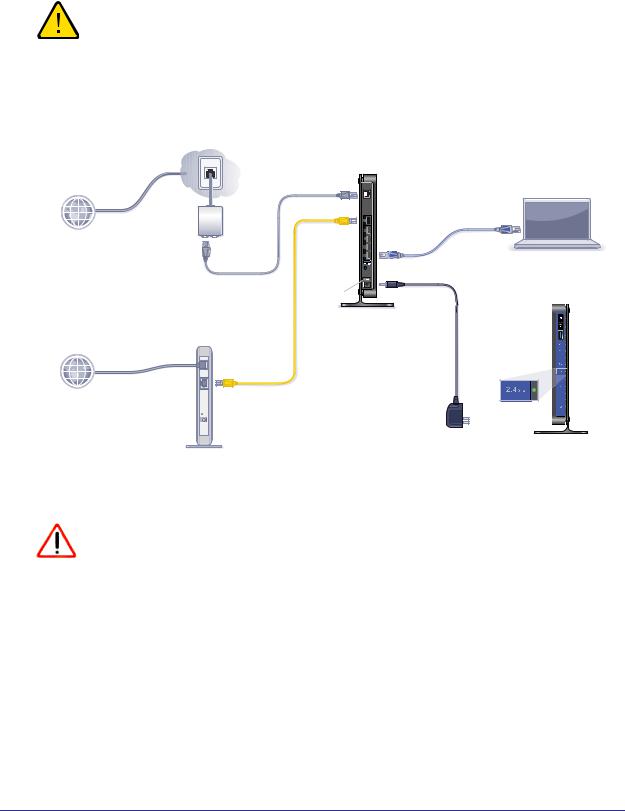
N600 Wireless Dual Band Gigabit ADSL2+ Modem Router DGND3700
Cable Your N600 Wireless Modem Router
WARNING!
DO not stack equipment, or place equipment in tight spaces, or in drawers. Be sure your equipment is surrounded by at least
2 inches of air space. The unit should not be wall mounted.
The installation guide that came in the box has a cabling diagram on the first page.
Connect to ADSL if connecting directly to a DSL line.
Line
ADSL |
Phone |
Internet
Note:Add an ADSL filter for every telephone on the same phone line as your wireless modem router.
Step 1:
Connect to Internet with ADSL or Ethernet WAN.
Internet
Connect to Ethernet WAN if connecting to a
fiber/cable modem.
Step 2:
Cable your computer.
Phone cable |
|
Ethernet cable |
Ethernet cable |
|
|
|
(not included) |
Power On/Off |
Power adapter |
|
N600 Wireless Modem Router
Note: Keep the DGND3700 N600 Wireless Modem Router in a vertical position.
Step 3:
Power on your router.
Wait until the 2.4 GHz Wireless LED turns solid green.
Laptop or desktop computer
2.4 GHz
Wireless LED
N600 Wireless Modem Router
Fiber/Cable modem
Figure 7. Cabling diagram
CAUTION:
Incorrectly connecting a filter to your wireless modem router blocks your ADSL connection.
Verify the Cabling
Verify that your router is cabled correctly by checking the wireless modem router LEDs. Turn on the wireless router by pressing the Power On/Off button on the back.
•
 The Power LED is green when the modem router is turned on.
The Power LED is green when the modem router is turned on.
•
 The LAN port is green when a PC is cabled to the router by an Ethernet cable.
The LAN port is green when a PC is cabled to the router by an Ethernet cable.
•


 The Wireless LEDs are lit when the modem router is turned on.
The Wireless LEDs are lit when the modem router is turned on.
Hardware Setup
20

N600 Wireless Dual Band Gigabit ADSL2+ Modem Router DGND3700
•
 The DSL LED is green when you have an ADSL connection.
The DSL LED is green when you have an ADSL connection.
•
 The Internet LED is red when there is no Internet connection.
The Internet LED is red when there is no Internet connection.
Turn on your computer. If software usually logs you in to your Internet connection, do not run that software. Cancel it if it starts automatically.
For More Information
For more information about the topics covered in this manual, visit the support website at http://support.netgear.com.
Hardware Setup
21

2. Router Internet Setup |
2 |
Connecting to the network |
This chapter explains how to set up your Internet connection using one of two methods: Setup Wizard or manual setup. If you have already set up your router using one of these methods, the initial router setup is complete. Refer to this chapter if you want to become familiar with the router menus, view or adjust the initial settings, or change the router password and login time-out.
This chapter contains the following sections:
•Router Setup Preparation
•Log In to the N600 Modem Router
•Upgrade Router Firmware
•Router Interface
•Setup Wizard
•Manual Setup (Basic Settings)
•ADSL Settings
•Unsuccessful Internet Connection
•Change Password and Login Time-Out
•Log Out Manually
•Types of Logins
22

N600 Wireless Dual Band Gigabit ADSL2+ Modem Router DGND3700
Router Setup Preparation
You can set up your wireless modem router with the Setup Wizard as described in Setup Wizard on page 27 or manually as described in Manual Setup (Basic Settings) on page 28. However, before you start the setup process, you need to have your ISP information on hand and make sure the laptops, PCs, and other devices in the network have the settings described here.
Note: If you have a Macintosh or Linux system, you have to use the manual setup method.
Use Standard TCP/IP Properties for DHCP
If you configured your computer to use a static IP address, you need to change the settings back so that it uses Dynamic Host Configuration Protocol (DHCP). See Appendix A, Supplemental Information for more information.
Replace an Existing Router
To replace an existing router, disconnect it completely from your network and set it aside before starting the router setup.
Adapters and Security Settings
A wireless adapter is the wireless radio in your PC or laptop that lets the PC or laptop connect to a wireless network. Most PCs and laptops come with an adapter already installed, but if it is outdated or slow, you can purchase a USB adapter to plug into a USB port.
Make sure the wireless adapter in each computer in your wireless network supports the same security settings as the wireless modem router. See Wireless Security Requirements and Recommendations on page 37 for information about the router’s security settings.
Note: If you connect devices to your modem router using WPS as described in Wi-Fi Protected Setup (WPS) Method on page 40, those devices assume the security settings of the router.
Gather ISP Information
You need the following information to set up your wireless modem router and to check that your Internet configuration is correct. Your Internet service provider (ISP) should have provided you with all of the information needed to connect to the Internet. If you cannot locate
Router Internet Setup
23
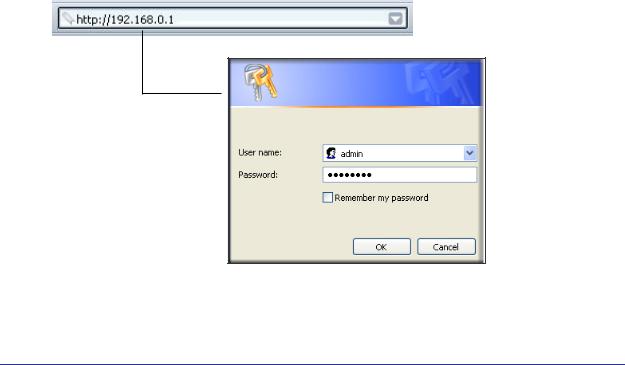
N600 Wireless Dual Band Gigabit ADSL2+ Modem Router DGND3700
this information, ask your ISP to provide it. When your Internet connection is working, you no longer need to launch the ISP’s login program on your computer to access the Internet. When you start an Internet application, your wireless modem router automatically logs you in.
•Active Internet service provided by an ADSL account
•The ISP configuration information for your ADSL account
-ISP login name and password
-ISP Domain Name Server (DNS) addresses
-Fixed or static IP address
-Host and domain names
-Depending on how your ISP set up your Internet account, you could need to know one or more of these settings for a manual setup:
-Virtual path identifier (VPI) and virtual channel identifier (VCI) parameters
-Multiplexing method
-Host and domain names
Log In to the N600 Modem Router
Log in to the wireless modem router to view or change settings or to set up the wireless modem router.
To log in:
1.Type http://192.168.0.1 in the address field of your browser and press Enter to display the login window. You can also enter either of these addresses to access the wireless modem router: http://www.routerlogin.net or http://www.routerlogin.com.
Figure 8. Log in with user name and password
2.When prompted, enter admin for the router user name and password for the router password, both in lowercase letters, and click OK.
Router Internet Setup
24

N600 Wireless Dual Band Gigabit ADSL2+ Modem Router DGND3700
Note: The router user name and password are probably different from the user name and password for logging in to your Internet connection. See Types of Logins on page 34 for more information.
The router screens display, where you can do things like changing settings or adding other devices to your network. For a brief description of the available functionality, see Router Interface on page 26. For information about adding devices to your network, see
Wi-Fi Protected Setup (WPS) Method on page 40.
If you do not see the login prompt:
1.Check the LEDs on the router front panel to make sure that the modem router is plugged into an electrical outlet, its power is on, and the Ethernet cable between your computer and the router is connected to a LAN port.
2.If you connected the Ethernet cable and quickly launched your browser and typed in the router URL, your computer might need a minute or two to recognize the LAN connection. Relaunch your browser and try again.
3.If you are having trouble accessing the router wirelessly, NETGEAR recommends that during setup you use an Ethernet cable to connect your computer so that you can log in to the wireless modem router.
Note: If you cannot connect to the wireless router, check the Internet Protocol (TCP/IP) properties in the Network Connections section of your PC Control Panel. They should be set to obtain both IP and DNS server addresses automatically.
Upgrade Router Firmware
When you log in and if you are connected to the Internet, the Firmware Upgrade Assistant screen displays so you can upgrade to the latest available firmware. For more information about upgrading firmware, see Chapter 5, Network Maintenance.
To upgrade the firmware:
1.Click Yes to check for new firmware (recommended). The modem router checks the NETGEAR database for new firmware.
2.If no new firmware is available, click No to exit. You can check for new firmware later.
3.If new firmware is available, click Yes to upgrade the router with the latest firmware. After the upgrade, the router restarts.
Router Internet Setup
25
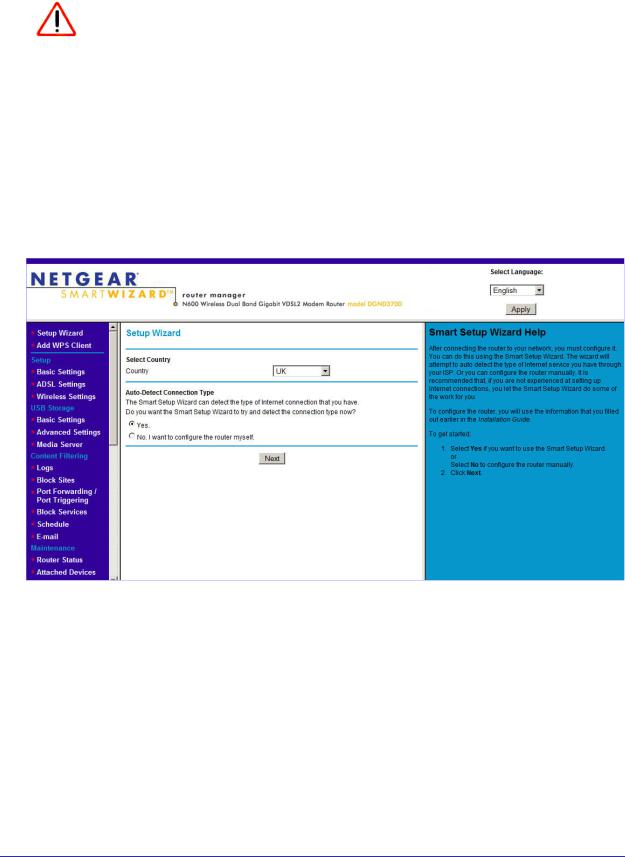
N600 Wireless Dual Band Gigabit ADSL2+ Modem Router DGND3700
CAUTION:
Do not try to go online, turn off the router, shut down the computer, or do anything else to the router until the router finishes restarting.
You cannot upgrade firmware until you have established your Internet connection as described in Setup Wizard on page 27.
Router Interface
The router interface gives you access to the router’s current settings so you can view or change them (if needed). The left column has the router menus, and the right column provides online help. The middle column is the screen for the current menu option.
Figure 9. Router interface
Setup Wizard
Specify the language and location, and automatically detect the Internet connection. See
Setup Wizard on page 27.
Add WPS Client
Add WPS-compatible wireless devices and other equipment to your wireless network. See
Add Clients (Devices) to Your Network on page 40.
Router Internet Setup
26

N600 Wireless Dual Band Gigabit ADSL2+ Modem Router DGND3700
Setup Menu
Set, upgrade, and check the ISP and wireless network settings of your router. See Manual Setup (Basic Settings) on page 28 and ADSL Settings on page 32. See also Chapter 3, Wireless Settings, for information about preset and basic security settings.
USB Storage Menu
Add removable storage to your network. See Chapter 6, USB Storage.
Content Filtering Menu
View and configure the router firewall settings to prevent objectionable content from reaching your PCs. See Chapter 4, Security Settings.
Maintenance Menu
Administer and maintain your router and network. See Chapter 5, Network Maintenance.
Advanced Menu
Set the router up for unique situations such as when remote access by IP or by domain name from the Internet is needed. See Chapter 8, Advanced Settings. Using this menu requires a solid understanding of networking concepts.
Advanced – VPN Menu
Set up secure encrypted communications. See Chapter 7, Virtual Private Networking. Using this menu requires a solid understanding of networking concepts.
Web Support
Go to the NETGEAR support site to get information, help, and product documentation. These links work once you have an Internet connection.
Setup Wizard
You have to log in to the modem router to set the country, language, and Internet connection.
Router Internet Setup
27

N600 Wireless Dual Band Gigabit ADSL2+ Modem Router DGND3700
To use the Setup Wizard:
1. Select Setup Wizard from the top of the router menus to display the following screen:
Figure 10. Country and language settings in Setup Wizard
2.Select your country and language:
•Country. It is important to specify the location where the wireless modem router operates so that the Internet connection works correctly. The default is UK.
•Language. The default is English. You can select another language if you prefer.
3.Select either Yes or No, I want to configure the Router myself. If you select No, proceed to Manual Setup (Basic Settings) on page 28.
4.If you selected Yes, click Next.
With automatic Internet detection, the Setup Wizard searches your Internet connection for servers and protocols to determine your ISP configuration.
Note: The Setup Wizard cannot detect a Point-to-Point Tunneling Protocol (PPTP) connection. If your ISP uses PPTP, you have to set your Internet connection through the screen described in Manual Setup (Basic Settings) on page 28.
Manual Setup (Basic Settings)
The Basic Settings screen displays when you select No. I want to configure the Router myself in the Setup Wizard and is also available from the router menus. It is where you view or change ISP information. The fields that display vary depending on whether or not your Internet connection requires a login.
Note: Check that the country and language are set as described Setup
Wizard on page 27 before proceeding with the manual setup.
Router Internet Setup
28

N600 Wireless Dual Band Gigabit ADSL2+ Modem Router DGND3700
To set up the basic settings manually:
1.Select Set Up > Basic Settings and select Yes or No depending on whether or not your ISP requires a login. Figure 11, Basic Settings screen without (left) and with (right) login shows both forms of the Basic Settings screen.
•Yes. Select the encapsulation method and enter the login name. If you want to change the login time-out, enter a new value in minutes.
•No. Enter the account and domain names, as needed.
2.Enter the settings for the IP address and DNS server. The default ADSL settings usually work fine. If you have problems with your connection, check the ADSL settings and see ADSL Settings on page 32 for more information.
3.If no login is required, you can specify the MAC Address setting.
4.Click Apply to save your settings.
5.Click Test to test your Internet connection. If the NETGEAR website does not appear within 1 minute, and see Troubleshooting on page 145.
Router Internet Setup
29
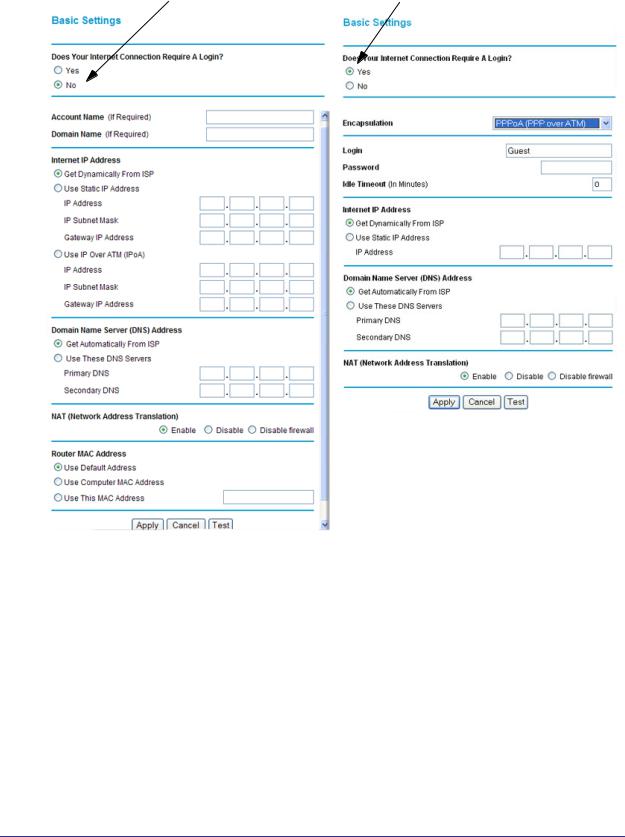
N600 Wireless Dual Band Gigabit ADSL2+ Modem Router DGND3700
ISP does not require login |
ISP does require login |
|
|
|
|
|
|
|
|
|
|
Figure 11. Basic Settings screen without (left) and with (right) login
The following table explains all of the possible fields in the Basic Settings screen. Note that which fields appear in this screen depends on whether or not a login is required.
Table 11. Basic Settings Screen Description
Settings |
|
Description |
||
|
|
|
||
Does Your ISP Require a Login? |
• |
Yes |
||
|
|
• |
No |
|
These fields |
Account Name |
Enter the account name provided by your ISP. This might also be |
||
display only if |
(If required) |
called the host name. |
||
no login is |
|
|
|
|
Domain Name |
Enter the domain name provided by your ISP. |
|||
required. |
||||
|
(If required) |
|
|
|
Router Internet Setup
30
